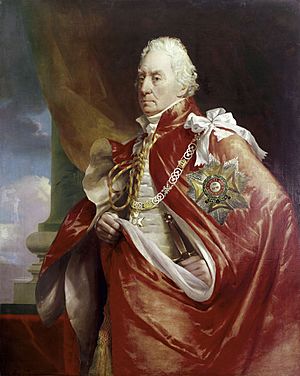George Elphinstone, 1st Viscount Keith facts for kids
Quick facts for kids
The Viscount Keith
|
|
|---|---|
 |
|
| Birth name | George Keith Elphinstone |
| Born | 17 January 1746 Elphinstone Tower, Falkirk |
| Died | 10 March 1823 (aged 77) Tulliallan Castle, Kincardine |
| Allegiance | |
| Branch | Royal Navy |
| Service years | 1761–1823 |
| Rank | Admiral of the Red |
| Wars | |
| Awards |
|
George Keith Elphinstone, 1st Viscount Keith (born January 17, 1746 – died March 10, 1823), was an important British naval officer. He served during a time of many big wars, including the American Revolutionary War, the French Revolutionary Wars, and the Napoleonic Wars. He rose through the ranks to become an Admiral and was known for his leadership and skill at sea.
Contents
A Young Sailor's Start
George Elphinstone was born in Scotland in 1746. He was one of four brothers. Two of his older brothers joined the army, and another joined the navy before working for the East India Company. George decided to follow his brother into the navy.
He joined his first ship, the 100-gun HMS Royal Sovereign, in 1761 when he was just 15 years old. Soon after, he moved to the frigate HMS Gosport. While serving on the Gosport, he took part in a battle that helped remove the French from Newfoundland. After this, he served on other ships in the Mediterranean Sea.
In 1766, he got permission to leave his ship and join his brother William on an East India Company ship called Tryton. They sailed to China, and their uncle helped them by lending them money for the trip, which allowed them to make a profit. George continued to advance in the navy, becoming a lieutenant in 1770, a commander in 1772, and a post-captain in 1775.
Leading Ships and Brigades
During the American Revolutionary War, George Elphinstone commanded the 50-gun HMS Warwick. He helped fight against enemy privateers (ships that attacked merchant vessels). He also led a group of sailors, called a naval brigade, during the capture of Charleston, South Carolina. In 1781, he captured a strong Dutch ship. A year later, in 1782, he led a group of ships that captured the French frigate Aigle.
After the war ended, he spent ten years on land. During this time, he served in the Parliament of Great Britain, representing areas in Scotland. In 1790, he was also chosen as a member of the Royal Society, a famous group for scientists.
Becoming an Admiral
When war started again in 1793, Elphinstone was given command of the 74-gun HMS Robust. He played a key role in the British occupation of Toulon in France. He bravely led a naval brigade of British and Spanish sailors on land and helped evacuate people when the town was later lost.
In 1794, he was promoted to rear-admiral. The next year, he was sent to capture Dutch colonies in South Africa, which led to the creation of the Cape of Good Hope Station. He helped capture the Cape in 1795 and, in 1796, captured an entire Dutch fleet in Saldanha Bay.
In 1797, when a large mutiny (rebellion) broke out among sailors at Nore, he was put in charge. He successfully helped bring order back to the fleet. He did the same at Plymouth, where another group of sailors was also restless.
Later, he became second-in-command to Admiral St Vincent in the Mediterranean. This was a difficult job because there were disagreements among the British naval commanders, including Horatio Nelson. Despite these challenges, he became commander-in-chief in the Mediterranean in 1799. He worked with the Austrians during the siege of Genoa, which was captured but then quickly lost again.
In 1801, he was responsible for transporting the army sent to take Egypt back from the French. There were no major sea battles, but his skill in managing the ships carrying the troops and landing them at Aboukir was highly praised.
Later Life and Legacy
For his service, George Elphinstone was made a Baron in 1797 and later a Viscount in 1814. He was put in charge of the North Sea fleet and later the English Channel fleet. In these roles, he helped protect Britain from invasion and managed many smaller naval operations.
He was at Plymouth when Napoleon surrendered and was brought to England. Lord Keith was the one who communicated the British government's decisions to the former Emperor. He remained calm and focused on his orders.
Lord Keith passed away in 1823 at his home, Tulliallan Castle, in Scotland. He was buried in the local church.
Family Life
George Keith Elphinstone was married twice. His first wife was Jane Mercer, and his second was Hester Thrale. He had one daughter from each marriage, but no sons. Because he had no sons, his title of Viscount ended when he died. However, his elder daughter, Margaret, inherited his other titles.
Freemasonry
He became a member of Scottish Freemasonry in Lodge Holyrood House (St Luke's) in 1769.
In Books
Lord Keith and his second wife, Hester, appear as characters in some of Patrick O'Brian's Aubrey–Maturin series of novels, which are popular historical adventure stories about the navy.
Images for kids


